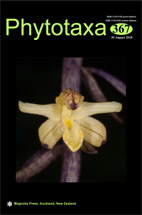Abstract
We found one specimen of Dermea on dead branches of an unknown tree in Arasbaran forests of Iran in 2015. Based on phylogenetic analysis of combined ITS, LSU, SSU sequence data, as well as morphological observations, a new species of Dermea, D. persica, is described and illustrated here. This species, the only species of Dermea lacking a sexual morph, is mainly characterized by beaked pycnidia, hyaline to pale brown at the base and dark brown at the apex, opening by a circular ostiole, discrete or integrated conidiogenous cells with a minute periclinal wall thickening and falcate, aseptate conidia, 20–25(–30) × 2.5–3.5 µm, and lacking microconidia. The relatedness between D. persica and its close relatives is discussed. An updated key to Dermea species is also provided.
References
https://doi.org/10.1016/j.funbio.2015.09.013
Crous, P.V. & Groenewald, J.Z. (2016) They seldom occur alone. Fungal Biology 120: 1392–1415.
https://doi.org/10.1016/j.funbio.2016.05.009
Dayarathne, M.C., Maharachchikumbura, S.S.N., Jones, E.B.G., Goonasekara, I.D., Bulgakov, T.S., Al-Sadi, A.M., Hyde, K.D., Lumyong, S. & McKenzie, E.H.C. (2017) Neophyllachora gen nov. (Phyllachorales), three new species of Phyllachora from Poaceae and resurrection of Polystigmataceae (Xylariales). Mycosphere 8: 1598–1625.
https://doi.org/10.5943/mycosphere/8/10/2
Di Cosmo, F. (1978) A revision of Corniculariella. Canadian Journal of Botany 56: 1665–1690.
https://doi.org/10.1139/b78-197
Eriksson, O.E. (2005) Outline of Ascomycota 2005. Myconet 11: 1–113.
Fries, E.M. (1825) Systema Orbis Vegetabilis 1: 1–374.
Fries, E.M. (1849) Summa Vegetabilum Scandinaviae. Vol. 2. Uppsala: Typographia Academica.
Funk, A. (1967) Dermea pseudotsugae n.sp., a causal agent of phloem necrosis in douglas fir. Canadian Journal of Botany 45: 1803–1809.
https://doi.org/10.1139/b67-193
Funk, A. (1976) The genus Dermea and related conidial states on Douglas fir. Canadian Journal of Botany 54: 2852–2856.
https://doi.org/10.1139/b76-306
Funk, A. & Kuijt, J. (1970) Dermea rhytidiformans n. sp., the fungus associated with the cork-bark of alpine fir. Canadian Journal of Botany 48: 1481–1483.
https://doi.org/10.1139/b70-223
Groves, J.W. (1946) North American species of Dermea. Mycologia 38: 351–431.
https://doi.org/10.2307/3755184
Groves, J.W. (1951) A Dermea on Prunus from China. Mycologia 43: 719–722.
https://doi.org/10.2307/3755492
Higgins, D., Thompson, J., Gibson, T., Thompson, J.D., Higgins, D.G. & Gibson, T.J. (1994) CLUSTAL W: improving the sensitivity of progressive multiple sequence alignment through sequence weighting, position-specific gap penalties and weight matrix choice. Nucleic Acids Research 22: 4673–4680.
https://doi.org/10.1093/nar/22.22.4673
Hillis, D.M. & Bull, J.J. (1993) An empirical test of bootstrapping as a method for assessing confidence in phylogenetic analysis. Systematic Biology 42: 182–192.
https://doi.org/10.1093/sysbio/42.2.182
Johnston, P., Seifert, K.A., Stone, J.K., Rossman, A.Y. & Marvanová, L. (2014) Recommendations on generic names competing for use in Leotiomycetes (Ascomycota). IMA Fungus 5: 91–120.
https://doi.org/10.5598/imafungus.2014.05.01.11
Kirk, P.M., Cannon, P.F., Minter, D.W. & Stalpers, J.A. (2008) Ainsworth & Bisby’s Dictionary of Fungi. 10<sup>th</sup> edn. Wallingford: CAB International.
https://doi.org/10.1079/9780851998268.0000
Mc Neill, J., Barrie, F.R., Buck, W.R., Demoulin, V., Greuter, W., Hawksworth, D.L., Herendeen, P.S., Knapp, S., Marhold, K., Prado, J., Prud‘Homme Van Reine, W.F., Smith, G.F., Wiersema, J.H. & Turland, N.J. (2012) International code of nomenclature for algae, fungi, and plants (Melbourne Code). Regnum Vegetabile 154: 1–240.
Mehrabi, M., Hemmati, R., Vasilyeva, L.N. & Trouillas, F.P. (2016) Diatrypella macrospora sp. nov. and new records of Diatrypaceous fungi from Iran. Phytotaxa 252 (1): 43–55.
https://doi.org/10.11646/phytotaxa.252.1.4
Norvell, L.L. (2011) Fungal nomenclature. 1. Melbourne approves a new Code. Mycotaxon 116: 481–490.
https://doi.org/10.5248/116.481
Oliveira, R.J.V., Lima, T.E.F., Cunha, I.B., Coimbra, V.R.M., Silva, G.A., Bezerra, J.L. & Cavalcanti, M.A.Q. (2014) Corniculariella brasiliensis, a new species of coelomycetes in the rhizosphere of Caesalpinia echinata (Fabaceae, Caesalpinioideae) in Brazil. Phytotaxa 178 (3): 197–204.
https://doi.org/10.11646/phytotaxa.178.3.5
Ramakrishnan, T.S. & Ramakrishnan, K. (1948) Additions to fungi of Madras IV. Proceedings of the Indian Academy of Sciences Section B. 27: 33–46.
Rambaut A. (2012) FigTree version 1.4.0. Available from: http://tree.bio.ed.ac.uk/software/figtree/ (accessed 22 August 2018)
Reid, J. & Pirozynski, K.A. (1966) Notes on some interesting North American fungi. Canadian Journal of Botany 44: 645–653.
https://doi.org/10.1139/b66-077
Rossman, A.Y., Aime, M.C., Farr, D.F., Castlebury, L.A., Peterson, K.R. & Leahy, R. (2004) The coelomycetous genera Chaetomella and Pilidium represent a newly discovered lineage of inoperculate discomycetes. Mycological Progress 3: 275–290.
https://doi.org/10.1007/s11557-006-0098-4
Sutton, B.C. (1980) The Coelomycetes: Fungi imperfecti with pycnidia, acervuli and stromata. UK: Commonwealth Mycological Institute, Kew, Surrey, England.
Sutton, B.C. (1991) Notes on Deuteromycets III. Sydowia 43: 264–280.
Swofford D.L. (2003) PAUP*: Phylogenetic Analysis Using Parsimony (*and other methods) Version 4.0b10. Sinauer Associates, Sunderland, Massachusetts.
Tamura, K., Stecher, G., Peterson, D., Filipski, A. & Kumar, S. (2013) MEGA6: Molecular Evolutionary Genetics Analysis Version 6.0. Molecular Biololgy and Evolution 30: 2725–2729.
https://doi.org/10.1093/molbev/mst197
Verkley, G.J.M. (2001) On Sphaerographium petiolicola and a new species, S. tenuirostrum, taxa from a rarely collected genus of coelomycetes. Mycologia 93: 205–211.
https://doi.org/10.2307/3761617
Verkley, G.J.M. (2002) A revision of the genus Sphaerographium and the taxa assigned to Rhynchophoma (anamorphic Ascomycetes). Nova Hedwigia 75: 433–450.
https://doi.org/10.1127/0029-5035/2002/0075-0433
Verkley, G.J.M., Zijlstra, J.D., Summerbell, R.C. & Berendse, F. (2003) Phylogeny and taxonomy of root-inhabiting Cryptosporiopsis species, and C. rhizophila sp. nov., a fungus inhabiting root of several Ericaceae. Mycological Research 107: 689–698.
https://doi.org/10.1017/S0953756203007883
Vilgalys, R. & Hester, M. (1990) Rapid genetic identification and mapping of enzymatically amplified ribosomal DNA from several Cryptococcus species. Journal of Bacteriology 172: 4238–4246.
https://doi.org/10.1128/jb.172.8.4238-4246.1990
Wang, Z., Johnston, P.R., Takamatsu, S., Spatafora, J.W. & Hibbett, D.S. (2006) Toward a phylogenetic classification of the Leotiomycetes based on rDNA data. Mycologia 98: 1065–1075.
https://doi.org/10.1080/15572536.2006.11832634
White, T.J., Bruns, T., Lee, S. & Taylor, J. (1990) Amplification and direct sequencing of fungal ribosomal RNA genes for phylogenetics. In: Innis, M.A., Gelfand, D.H., Sninsky J.J. & White T.J. (Eds.) PCR protocols: a guide to methods and applications. Academic Press, New York, pp. 315–322.
https://doi.org/10.1016/B978-0-12-372180-8.50042-1
Wijayawardene, N.N., Hyde, K.D., Lumbsch, H.T., Liu, J.K., Maharachchikumbura, S.S. N., Ekanayaka, A.H., Tian, Q. & Phookamsak, R. (2018) Outline of Ascomycota: 2017. Fungal Diversity 88: 167–263.
https://doi.org/10.1007/s13225-018-0394-8
Wijayawardene, N.N., Hyde, K.D., Rajeshkumar, K.C., Hawksworth, D.L et al. 2017a. Notes for genera: Ascomycota. Fungal Diversity 86: 1–594.
https://doi.org/10.1007/s13225-017-0386-0
Wijayawardene, N.N., Hyde, K.D., Tibpromma, S., Wanasinghe, D.N., Thambugala, K.M., Tian, Q., Wang, Y. & Fu, L. (2017b) Towards incorporating asexual fungi in a natural classification: checklist and notes 2012–2016. Mycosphere 8: 1457–1554.
https://doi.org/10.5943/mycosphere/8/9/10

